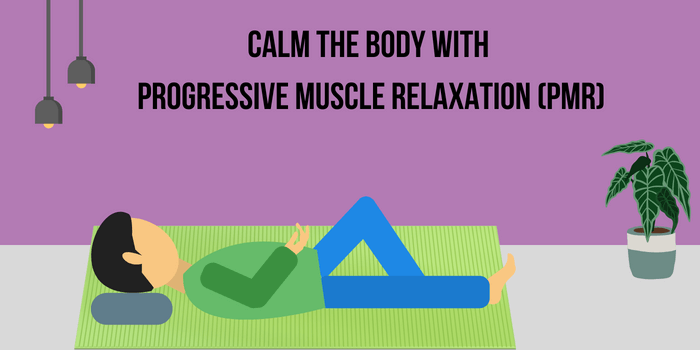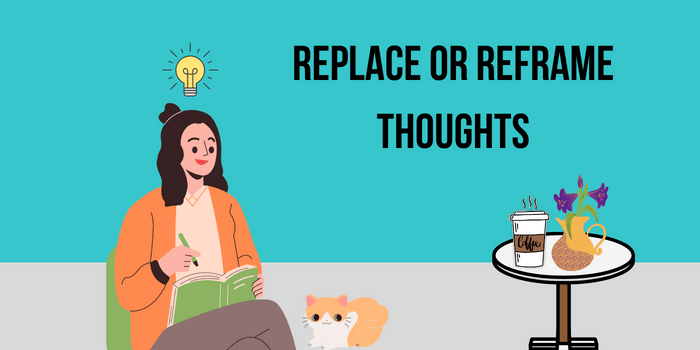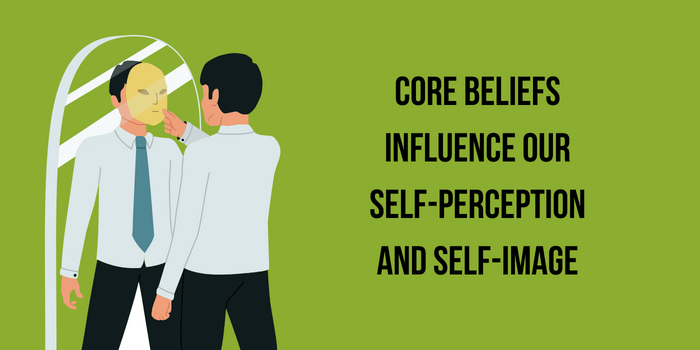To overcome negative thinking, we must identify thought patterns that cause negative feelings, and replace them with more balanced and healthy ways of thinking.
Negative thinking must be handled at 3 levels.
Strategy: Handle negative thoughts at 3 levels
To overcome negative thinking, you must handle it at 3 levels:
Level 1: At the physiological level
Level 2: At the level of thoughts themselves
Level 3: At the core beliefs level
Level 1: Physiological
As you have seen, a negative thought can have physiological effects such as rapid heartbeat, muscles tensing up, sweating etc. Essentially, it creates a sense of threat and the body goes into threat response or fight-flight-freeze mode.
Technique: Progressive Muscle Relaxation
When you’re struggling with a negative thought, the immediate priority is to calm your body down. When the body is calm, it signals the brain that there is no danger and you can relax.
Progressive Muscle Relaxation or PMR is an excellent way to do this.
PMR involves systematically tensing and then relaxing different muscle groups in the body, starting with the feet and moving up to the head. The idea is to focus on the sensations in each muscle group as it is tensed and then relaxed, allowing the person to become more aware of their body and any areas of tension.
This awareness can help to reduce overall muscle tension and promote feelings of relaxation and well-being. Progressive muscle relaxation is typically done while lying down or sitting comfortably, and can be done in 10-20 minutes.
Here is a guided PMR video that you can follow along with.
Level 2: Thoughts
Here is a key idea. Your thoughts are not facts.
Just because you think something, doesn’t necessarily mean it’s true. Your thoughts can be influenced by a number of factors, including your past experiences, your beliefs, and your emotions.
Many of these thoughts are automatic, which means they pop into our minds without us consciously thinking them. Automatic thoughts can be positive or negative, and can affect our mood and behavior.
For example, if someone makes a critical comment, we might automatically think, “I’m not good enough,” which could lead to feelings of inadequacy and low self-esteem.
On the other hand, if we receive a compliment, we might automatically think, “I’m smart and capable,” which could boost our confidence and self-esteem.
Automatic thoughts can be helpful in some cases, but they can also be unhelpful and even damaging if they are based on negative or distorted beliefs.
By understanding automatic thinking and recognizing that thoughts are not facts, develop more balanced and realistic ways of thinking.
Technique: Identify, Challenge, Replace
To deal with automatic negative thoughts, you must identify the thought, challenge it, and then replace or reframe it.
Identify: First, try to become aware of your thoughts and feelings in the moment. This can be challenging, as our thoughts often happen automatically and we may not even realize we’re having them.
Pay attention to your emotions and any physical sensations you’re experiencing, as these can be clues that you’re having an automatic thought. Next, try to identify the trigger for the thought. What event or situation seemed to set off the thought? Was it something someone said or did, or was it something you saw or experienced?
Once you’ve identified the trigger, try to label the thought. What is the thought telling you about yourself, others, or the situation? Is it positive or negative? Is it based on facts or is it distorted in some way?
Example: The thought is “I’m going to mess up my performance review.” Triggered by the sight of your boss walking by, without smiling at you.
Challenge: Now, try to challenge the thought. Is the thought helpful or unhelpful? Is it based on evidence or is it based on your prior beliefs that may not be true?
Our thoughts are often influenced by our beliefs and assumptions, which can be based on past experiences or other factors. Try to identify what they are.
Ask yourself these questions:
- Is there adequate evidence for my thoughts?
- Is there evidence contrary to my thought?
- What would a friend think about this situation?
- If I look at this situation from a positive perspective, how is it different?
- Is this going to matter 1 year or 5 years from now?
Example: Think about on what basis are you assessing a performance review that hasn’t even happened yet? Is there anything to suggest that it will definitely not go well? When was the last time you worried about a similar review, and it wasn’t true?
Replace or reframe: Once you’ve evaluated the evidence and identified any underlying assumptions or beliefs, try to come up with alternative, more balanced thoughts that take into account all the evidence and are less distorted.
Evaluate the new thoughts and choose the most helpful one. Choose the one that feels most helpful and try to focus on that thought instead of the negative one.
Ask yourself, given all of the evidence, is there a better way of framing the situation?
Example: Is there another explanation for the boss not smiling at you? Could he be bogged down by his own thoughts? Even if the performance review does not go well, what’s the worst that can happen? Is there a plan that you can fall back on?
Changing the way you think about a situation can help you see it in a whole new light.
Level 3: Core beliefs
Core beliefs are your central ideas about yourself, others, and the whole world. They develop over time, typically from childhood and your life experiences. Significant life events and life circumstances can lead to specific core beliefs that you use to judge every situation in your life.
In CBT, core beliefs are said to underlie your automatic thoughts.
To handle problematic core beliefs, apply the same structured logical thinking (as you did with thoughts) to the belief.
When thoughts arise, dig deeper and analyze what they mean. What is the seed of the thought? That is what will lead you to the core belief that gave rise to the thought.
Your core belief may be that you are incompetent, and that may be giving rise to the automatic thought that you’ll flunk your performance review.
Other core beliefs could be:
I’m not smart
I’m too slow
Nobody likes me
Challenge your negative core belief by asking yourself these questions:
- Can I support this belief with objective facts and evidence?
- What is the proof that this belief is true?
- Is there any proof that this belief is false?
- Even if I don’t get what I want, what’s the worst possible outcome?
- Are there positive things that I can cause to happen even if the worst happens?

Become A Morning Person Bootcamp
For calm mornings with a daily meditation & journaling routine
Conclusion
Negative thinking can be a difficult habit to break, but it is possible with the right tools and techniques. By becoming aware of your negative thoughts, practising gratitude, setting achievable goals, and seeking support from others, you can train your brain to think more positively and overcome negative thinking.
Remember to be patient with yourself and that it may take time to see significant changes, but with dedication and perseverance, you can overcome negative thinking and lead a happier, more fulfilling life.





